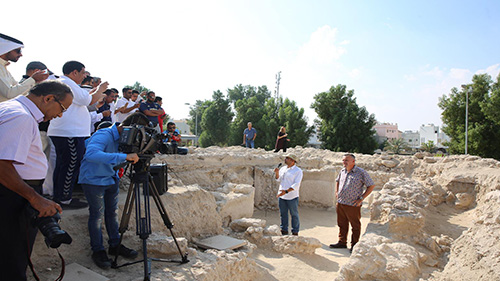28 November 2019
Bahrain Culture Authority Unveils First Archaeological Proof of Christian Monastery in Samaheej Area, Muharraq


Bahrain's Culture & Antiquities Authority (BACA) announced in a press conference on 28 November 2019, an important archaeological discovery, the first of its kind to constitute a missing link that will contribute to a better understanding of Christian history in the Kingdom of Bahrain. The on-site press conference attended by British-Bahrain Excavation team and the inhabitants of Samaheej village showcased this new rare archaeological discovery after many excavations were made at the site by the common British-Bahrain archaeologists led by Professor Timothy Insol, Dr Rachel MacLean from University of Exeter, and Dr Salman Al Mahari, Bahrain Authority for Culture & Antiquities.
Professor Timothy Insol commented on the event saying that it was the most important archaeological discovery in the region, expressing his gratitude and thanks to H.E Shaikha Mai Bint Mohammed Al Khalifa, President of Bahrain Authority for Culture & Antiquities, for her efforts to support the project, extending his thanks to Samaheej local community for their valuable support and assistance shown towards the excavation team and all facilities enjoyed to carry out their job.
Dr Salman Al Mahari, for his part, said that these archaeological findings reveal the Christian existence historically in the island of Muharraq, adding that season of excavation works has come to end temporarily, hoping that the next 2020 excavation season will bring more happy news with regard to archaeological discoveries in the area of Samaheej, Al-Dair until Qalali.
The texts mention a number of places and episcopal sees mainly around the Bahrain archipelago, and the archaeological finds are mainly churches and monasteries, which seem to bear several similarities in architecture and decoration despite the geographical dispersion, in addition to several lesser finds. Samaheej had a Nestorian Christian presence during its early history, with old foundations of a Nestorian monastery being discovered in the village. The site of the excavation consists of a high hill located in the center of the tomb of Samaheej topped by the remains of a small mosque known as "Sheikh Malik Mosque", probably dating from the 17th century, and below it is the Christian building. The archaeological discovery is a large building 17 meters long and 10 meters wide, which may have been part of a monastery or large house.
Samaheej archeological site tell had been previously the subject of excavations and explorations for three years by a Bahraini-British team led by Timothy Insole and Rachel McLean from the University of Exeter and Salman Almahari from Bahrain Authority for Culture and Antiquities in Samaheej area in Muharraq, before the team re-started their works gain this year.
Based on a study of the pottery artifacts discovered by Robert Carter, Professor of Arabian and Middle Eastern Archaeology, many broken pottery vessels which were also found used in storing wine, it is therefore possible that these Christians were part of the Nestorian Church, which probably flourished in the Gulf between the 5th and 7th centuries.
In addition of the pottery pieces , the building is made up of chambers with pieces of stone were inserted to complete the decoration in various gypsum and limestone. a decorated crucifix or cross was also found on pottery broken glassware and other pieces used for storing and drinking wine figure also among the finds, suggesting that those Christians of the Nestorian Church were part of the congregation that flourished during that period of time.







